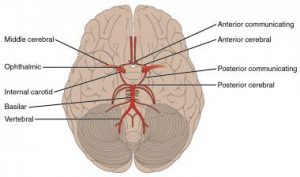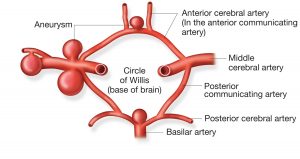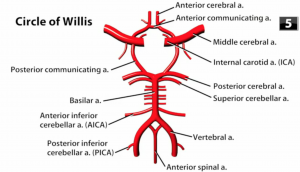The Circle of Willis is a part of the circulatory structure in the brain. It is named after Thomas Willis, the British physician. This structure is an anastomosis which is a link or a connection between two blood vessels. The Circle of Willis forms the vascular supply to the brain and the structures that surround it. It is also known as the polygon of Willis.
Location of the Circle of Willis
The structure is a circle of arteries that are interconnected and it is located at the base of the brain. It is located near the optic chiasm, the hypothalamus, and the pituitary stalk.
Anatomy of the Circle of Willis
It is formed by two arteries that interconnect (the internal carotid arteries) and two vertebral arteries.
The Internal Carotid Arteries
They form the vascular supply to the anterior portion of the brain, especially to the structures of the cerebral hemispheres and its neighboring parts.
These arteries originate from the right and left common carotid arteries that bifurcate at the fourth cervical vertebra (4 cervical vertebrae). The internal carotid artery then goes upwards through the carotid sheath and enters the cranial cavity where it shoots out one branch – the ophthalmic artery. It then curls into the front half of the cavernous sinus and moves upwards where it divides into the middle and the anterior cerebral artery.
It also branches off into the striate arteries, the anterior choroidal artery, and the anterior and posterior communicating arteries.
The Vertebral Arteries
They form the posterior source of vascular supply and supply the brainstem, the cerebellum and the back regions of the cerebral hemispheres. The arteries originate from the subclavian artery and move up the neck and converge at the lower portion of the pons to form the basilar artery. By extension, this forms the vertebrobasilar system. The vertebral arteries form branches that move downwards. They are the posterior and anterior spinal arteries and the posterior inferior cerebellar arteries.
The basilar artery moves upwards and branches off from the lower portion of the pons into the pontine arteries, the anterior inferior cerebellar arteries, and the superior cerebellar arteries. As it moves up, near the upper portion of the pons, it bifurcates into the right and left posterior cerebral arteries.
The posterior communicating arteries form the anastomosis with the posterior cerebral arteries and thus form the connection between the internal carotid arteries and the vertebrobasilar system, thereby completing the Circle of Willis.
Function of the Circle of Willis
The Circle of Willis is an important structure that provides the blood supply to the forebrain and the hindbrain. The network of arteries allows blood to be circulated to both hemispheres from the internal carotid arteries or the vertebral arteries. The multiple branches that arise from the circle further supply the cerebral hemispheres and the neighboring structures.
The Circle of Willis provides a safety function for the brain. If an artery on either side happens to be occluded, the Circle of Willis will allow blood to pass across the midline of the brain, allowing for collateral circulation to take place if the blood flow to one area is affected.
Circle of Willis Pictures
Associated Conditions
Thrombosis
When blood flow to the brain is interrupted, the brain does not receive adequate oxygen or nutrients, and this leads to many serious complications. One such condition is thrombosis where blood clots form inside the blood vessels and these clots block the flow of blood. If thrombosis of the anterior cerebral artery happens, it can lead to paralysis of the leg and the foot on the opposite side of the body. Thrombosis of the middle cerebral artery leads to loss of sensation on the opposite side of the body, mainly in the face and arm region. Thrombosis of the posterior cerebral artery causes visual interferences.
Intracerebral Aneurysms
When an artery dilates more than 50% of the diameter, an aneurysm is likely to occur. An aneurysm is dangerous with the likelihood of the artery rupturing. If this happens, it requires immediate medical attention and surgery; otherwise, it proves fatal for the individual.
Subclavian steal syndrome (SSS)
This is a collection of symptoms that arise when the blood flow in the vertebral artery or the internal thoracic artery is reversed. This often happens when there is narrowing or occlusion of the subclavian artery. When the blood flows in a reversed direction down the vertebral artery at the expense of the blood flow within the vertebrobasilar circulation, it is called the subclavian steal.
Frequently Asked Questions
1. What happens if the circle is asymmetrical?
If the Circle of Willis is asymmetrical, the flow of blood also becomes asymmetrical and this could result in intracranial strokes. Patients who suffer from aneurysms usually have anomalies in one of the arteries associated with the Circle of Willis.
2. Does the spinal cord get affected in any way if the arteries are blocked?
Yes. Sometimes when the vascular supply of the arteries is interrupted, it affects other parts of the nervous system as well. This could result in spinal strokes or spinal infarctions. The common symptoms include muscle weakness, paralysis, loss of reflexes and loss of sensitivity.
3. How does an incomplete Circle of Willis develop?
The anatomical variations that come with an incomplete Circle of Willis can be genetically determined. Sometimes they may develop in the early embryonic stage during prenatal development of the individual which continues into postnatal development.
The Circle of Willis is a network of arteries that are found at the base of the brain and forms the connection between two blood vessels. It provides the blood supply to the mid and forebrain and also regulates the flow of blood in case an artery gets blocked.




No comments yet.